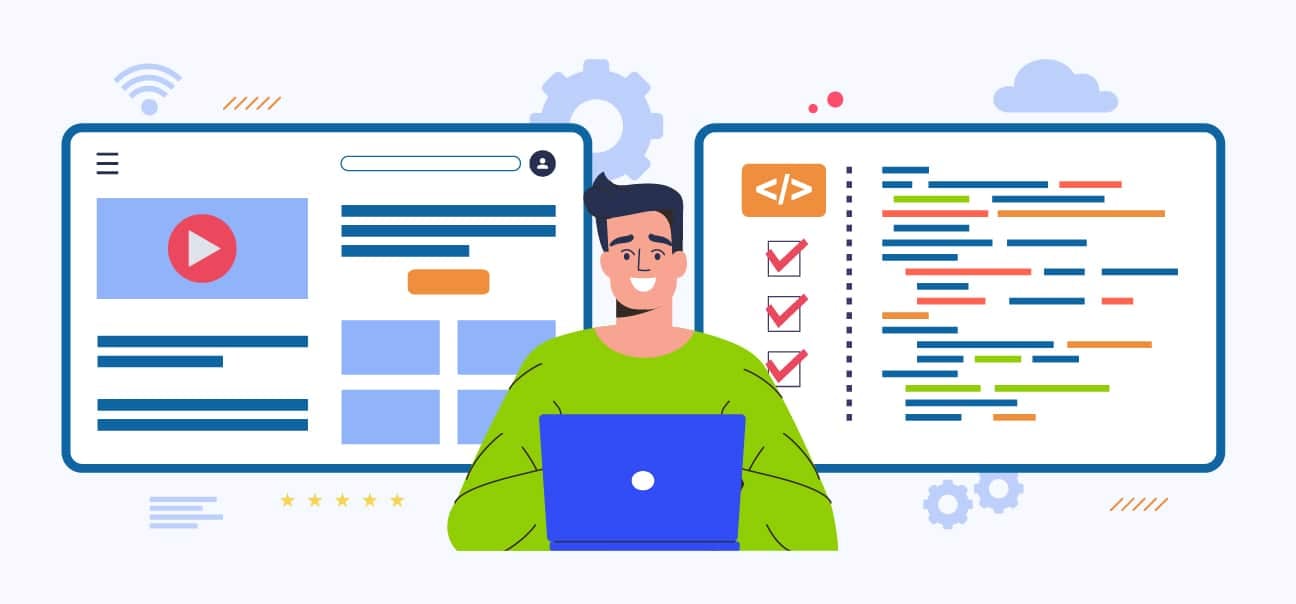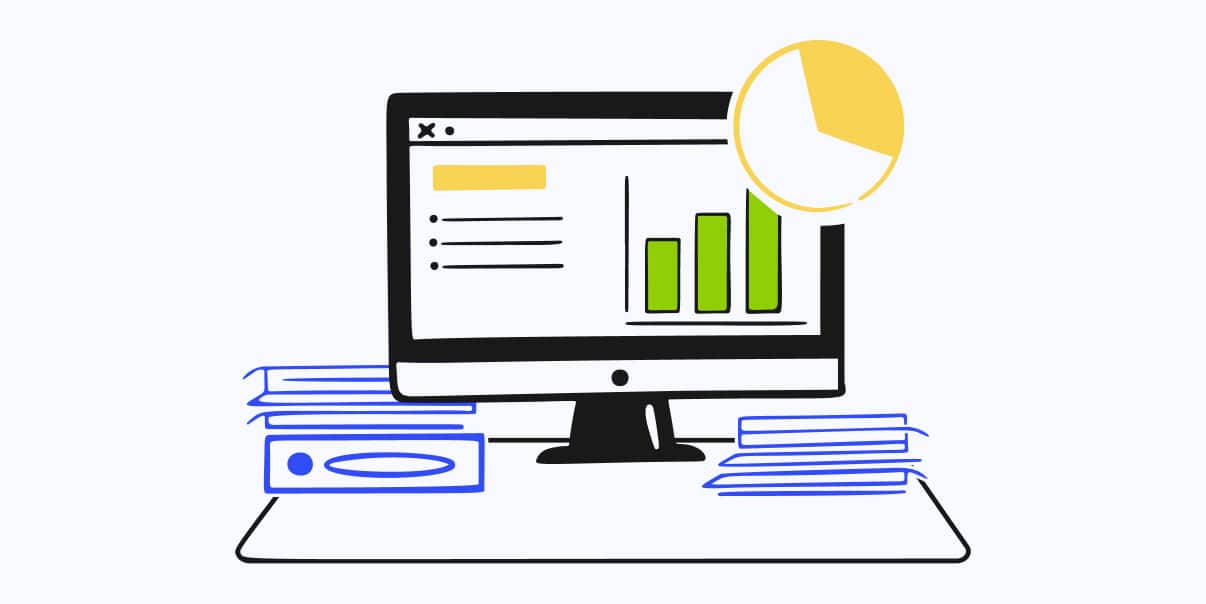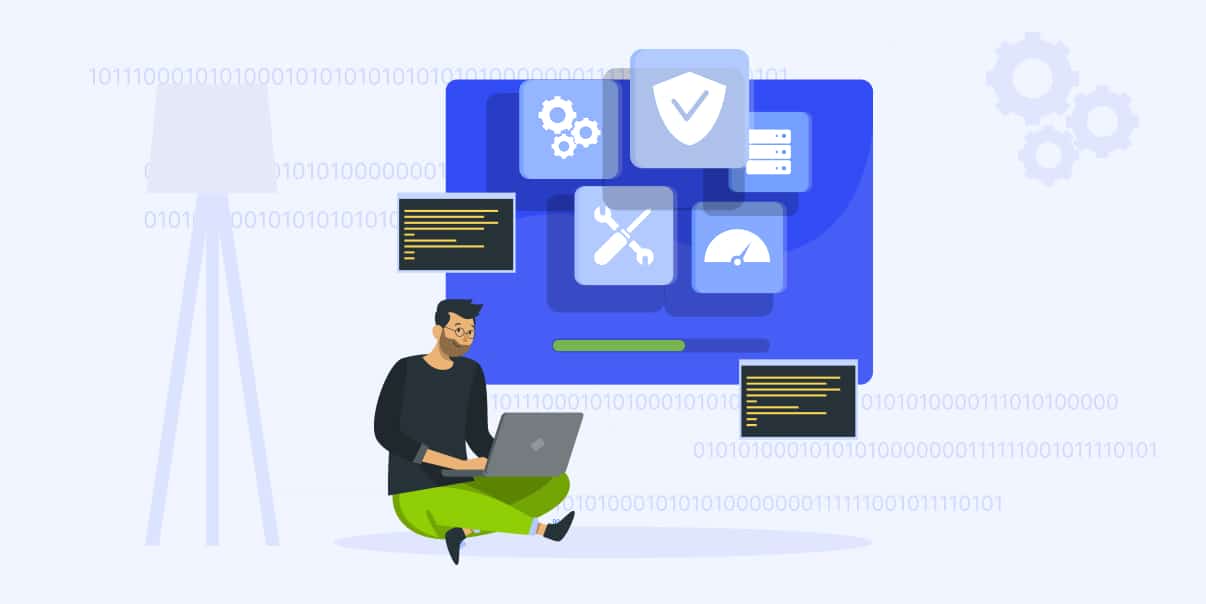Frontend vs. Backend Development
A Comprehensive Comparison for Modern Web Development

Web development has become crucial for connecting people and businesses. This fascinating field breaks down into two main parts: frontend and backend development. In this article, we’ll explore these areas to give you a better understanding of how they work together to create the websites and apps we use every day.
Front end development focuses on the client side of the website or apps. Meanwhile, back end development deals with behind-the-scenes processes. We’ll tackle the popular programming languages, frameworks, and skills needed in each area. Also, we’ll compare their performance and discuss the job market and career opportunities.
This article provides valuable information and resources to help you grow your knowledge and skills. So, read on and discover the exciting world of frontend and backend development!
Frontend Development
Frontend development is a vital part of making websites and apps. It focuses on the things you interact with on your screen. When you work on front-end development, your job is to ensure everything looks nice, is easy to use, and works well on different devices.
Role in Web Development
Frontend development is responsible for implementing the user interface (UI) and user experience (UX) design decisions made by UX designers. Front end developers create the UI and UX. They are responsible for ensuring a website or app looks good, functions well, and is easy to use. Also, they focus on UI design and use HTML, CSS, and JavaScript to design the look and feel of a site.
User Interface (UI)
UI is about the design and arrangement of elements on the screen, like buttons, menus, and text. As a front-end developer, you work on creating a clear and attractive UI. As a result, people can easily find and use the features they need.
User Experience (UX)
UX is about how enjoyable and straightforward it is for people to use a website or app. Good UX means users can quickly complete tasks and find what they want. Frontend developers work on improving UX to ensure users have a positive experience when using apps.
Popular Frontend Programming Languages
Below are the most popular frontend programming languages used for web development:
JavaScript
JavaScript is a programming language that puts interactivity to websites. With JavaScript, you can create animations, buttons that change when you click them, and even games. JavaScript makes websites more engaging and fun to use.
Typescript
Typescript is a statically-typed superset of JavaScript that brings type safety and additional features not present in JavaScript. It gets compiled into JavaScript so it can run in the browser.
Dart
Dart is a popular programming language developed by Google. It’s often used for making mobile apps but can also create interactive websites. Dart is unique because programmers can convert it to JavaScript, which web browsers understand. Also, programmers enjoy Dart’s flexibility and the tools it provides to write clear, stable code.
Frontend Frameworks and Libraries
Here are some popular frontend frameworks and libraries used for web development:
React
React is a library made by Facebook that helps web developers build user interfaces more easily. It lets you break down your interface into smaller parts called components. You can reuse and combine these components to create a complex, interactive web page. React simplifies creating and managing user interfaces, saving time and effort.
Angular
Angular is a framework developed by Google that provides tools and features for building web applications. It helps developers organize code better and makes creating dynamic, interactive content easier. Angular also has a built-in system for handling user input, navigation, and data management. Hence, it makes it a powerful tool for front-end development.
Vue.js
Vue.js is another popular framework for building user interfaces. It’s known for being lightweight and easy to learn, which makes it an excellent choice for beginners. Vue.js lets developers create reusable components and update the content on the screen without reloading the entire page. It makes building and maintaining websites and apps faster and more efficient.
Backend Development
Backend development is another crucial part of creating websites and apps. Back-end developers ensure the data users input is stored and processed correctly. And they handle other tasks, like user authentication and server management.
Role in Web Development
Back-end developers are responsible for making sure everything works behind the scenes. They create and maintain the databases that store user data and ensure websites run smoothly on different devices. Back-end development also involves creating APIs to allow various apps to communicate with each other.
Server-Side Logic
Backend developers create the code that runs on the server, which is the computer that hosts the website or app. This code controls how data is processed and how different parts of the website or app interact. Server-side logic ensures that everything works correctly and efficiently.
Database Management
Backend developers also work with databases, which store and organize the data used by websites and apps. They ensure the data is stored securely and can be accessed when needed. Backend developers create new database tables, update existing data, and retrieve information.
Popular Backend Programming Languages
Some of the most popular backend programming languages are as follows:
1. Python
Python is a versatile programming language popular for back-end development because it’s easy to read and write. It has a large community and many libraries, making it a top choice for various projects.
2. Ruby
Ruby is another popular backend programming language known for its readability and flexibility. Developers use it with the Ruby on Rails framework, which provides tools for creating web applications quickly and easily.
3. PHP
PHP is a widely-used programming language that is especially popular for creating websites. Designed to work well with HTML, PHP makes it easy to include server-side code within web pages.
4. Java
Java is a powerful programming language in large-scale web applications and enterprise systems. Its strong focus on reliability, security, and performance makes it popular.
5. JavaScript (with Node.js runtime environment)
You can use JavaScript for back-end development with the help of the Node.js runtime environment. Node.js lets developers use JavaScript on the server side. It makes writing both frontend and backend code in the same language possible.
Backend Frameworks
Web developers use a variety of frameworks to create websites and applications. Here are the most popular ones:
1. Django
Django is a popular Python framework for back-end development. It helps developers create web apps quickly by providing pre-built tools and features.
2. Ruby on Rails
Ruby on Rails, often called Rails, is a famous framework for building web apps using the Ruby programming language. It makes it easy to create and manage database-driven websites. Also, it includes tools for handling user input and creating dynamic content.
3. Laravel
Laravel provides a clean and elegant syntax, making writing code and creating web applications simple. It includes tools for tasks like routing, authentication, and database management.
4. Express.js
Express.js is an exceptional framework for building web apps using JavaScript and Node.js. It is easy to use and famous for creating APIs and simple web applications.
Performance Comparison of Frontend vs. Backend Development
When building websites and apps, frontend and backend development play critical roles. Each one has different strengths and weaknesses when it comes to performance. See the comparison below:
Speed and Efficiency in Frontend and Backend Development
Front-end development focuses on creating a fast and smooth experience for users. It involves optimizing the design and code to ensure that pages load quickly and animations run smoothly.
Meanwhile, backend development ensures developers perform data processing and server-side tasks efficiently. It includes handling user requests, storing and retrieving data, and performing calculations.
Scalability
Scalability means how well a website or app can handle expanding users or tasks. In frontend development, scalability ensures the design and code work well on different devices and screen sizes. It also means the website or app can handle increased traffic without slowing down. On the other hand, back-end development ensures the server and database can handle more users and requests as the website or app grows.
Adaptability
Adaptability refers to the ease with which developers can change or update a website or app. Frontend and backend development must be adaptable to add new features and fix problems. Adaptability involves using modular code and design patterns in front-end development. While in the backend, it means using good programming practices that make the code easy to understand and modify.
Integration With Third-Party Services
Many websites and apps use third-party services to add features or functionality. For example, a website might use a service that provides maps or weather information. Front-end and backend developers must integrate these services into the website or app.
In frontend development, it adds code to display the information provided by the service, like showing a map on the screen. Backend developers must handle data processing or communication with the service.
Security and Data Protection
Security is a critical concern for front-end and back-end development. Front-end developers ensure the UI prevents unauthorized access or misuse. It involves adding password protection, using secure forms, or encrypting data.
On the contrary, backend developers are responsible for securing the server and database. They set up firewalls, encrypt data, and monitor for security threats. Also, they ensure authorized users can only access data.
Web Developer Skills and Responsibilities
Web developers create websites and apps that people use every day. They have different skills and responsibilities. Thus, take a look at the skills needed for each type of developer and the duties they have below:
Required Skills for Frontend Developers:
- Understanding Programming Languages
A frontend developer must know languages like JavaScript and others like TypeScript or Dart. These languages make websites interactive and engaging.
- Design and Layout Skills
Developers should know how to use hypertext markup language (HTML) and cascading style sheets (CSS), or tools like them, to make websites look good and be easy to use.
- Problem-Solving Abilities
Websites can be complex, and things might not always work right. Developers must be good at finding and fixing problems, ensuring everything works smoothly for the user.
Required Skills for Backend Developers:
- Database Management
Backend developers also work with databases, which store and organize the data used by websites and apps. They ensure the data is stored securely and can be accessed when needed. Backend developers create new database tables, update existing data, and retrieve information when users request it.
- Server-Side Programming
Server-side programming involves writing code on the server, the computer hosting the website, or the app. Backend developers must know how to write code that processes data and handles user requests, such as logging in or submitting a form.
- API (Application Programming Interface) Development
APIs are a way for websites and apps to communicate and share data. Backend developers must know how to create APIs that let other developers access their website or app’s data.
Overlapping Skills and Full-Stack Development
Some web developers have frontend and backend development skills, known as full-stack development. A full-stack developer can work on both the user interface and the server-side code.
Also, full-stack developers may need to learn more skills and tools, such as version control systems like Git, which help them manage and track changes to their code.
Job Market and Career Opportunities
The job market and career opportunities for web developers are constantly changing. But there is always a need for skilled professionals who can create and maintain websites and apps.
Demand for Front End and Back End Developers
There is a high demand for developers because websites and apps are essential for business. Companies need a front-end developer to create user-friendly designs. They also need one to ensure their websites and apps work well on different devices.
Meanwhile, organizations need backend developers to manage their data and server-side processes. The demand for skilled developers will grow as more companies expand their online presence.
Salary Comparisons
Web developers can earn good salaries depending on their skills, experience, and location. Backend web developers earn slightly higher wages than frontend because of more complex tasks.
But, front-end developers with solid design and programming skills can also command high salaries. Full-stack developers with frontend and back-end development skills are often in high demand. They may earn even higher compensation because they work on various projects.
Future Trends in Web Development
Web development is constantly evolving. And there are several future trends that developers should be aware of, such as:
- Increased Focus on User Experience
As websites and apps become more advanced, companies will prioritize creating user-friendly designs. Doing so makes it easy for people to find information and complete tasks.
- Greater Emphasis on Security
Cyberattacks are becoming more common nowadays. Thus, web developers must stay informed about the latest security tools and practices. They must help protect websites and apps from threats.
- Continued Growth of Mobile Devices
More people use smartphones and tablets to access the Internet. So, web developers must ensure their websites and apps work well on these devices.
Tips for Choosing the Right Development Path
When deciding which development path to choose, consider the following tips:
- Think About Your Interests
You may prefer front-end development if you enjoy creating visually appealing designs and layouts. But if you are more interested in working with data and solving complex problems, back-end development might be a better fit.
- Learn the Basics
Start by learning basic front-end and back-end development skills. Doing so gives you a solid foundation and helps you decide which area to focus on.
- Gain Experience
Build or contribute to open-source projects to gain hands-on experience and develop your skills.
Conclusion
Ultimately, this frontend vs. backend development guide helps you create successful online experiences. By working and learning about new technologies and best practices, web developers can create websites and apps that are engaging, functional, and secure. If you want to understand more about web development, contact BIT Studios. We offer web development services that focus on creating excellent user experiences. We have experienced developers who create stunning apps and websites. Powerful servers and databases back them to ensure businesses get online quickly. Together, we can build exceptional online experiences and shape the future of the Internet!
We’re BIT Studios!
At BIT Studios we specialize in designing, building, shipping, and scaling beautiful, usable products with blazing-fast efficiency



